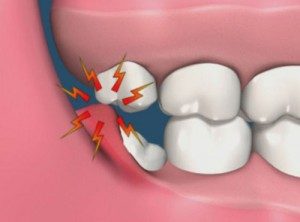Regular Exams and Cleanings
By brushing your teeth twice a day, flossing at least once a day, making smart food choices, and scheduling regular dental visits you can lower your risk for tooth decay, help with early detection of problems and avoid potentially painful and costly emergencies.
We recommend that patients visit at least twice a year for an oral health checkup. This is in line with the American Dental Association's national guidelines on oral health.
During your regular exam, we will:
- Check for any problems that you may not see or feel
- Look for cavities or any other signs of tooth decay
- Inspect your teeth and gums for gingivitis and signs of periodontal disease
- Perform a thorough teeth cleaning
Regular exams take about 1 hour. During your visit your blood pressure, heart rate, and medical history will be brought up to date and an assessment will be performed along with cleaning to remove tarter and plaque. Depending on the health of your gums we may also recommend cleaning under the gum tissue. Our objectives are to detect any existing or potential issues and avoid any preventable problems.

Bonding
Gaps, chips, and stains on your front teeth can detract from an otherwise amazing smile. If you're reluctant to try out a porcelain veneer then cosmetic bonding might be for you. Although bonding doesn't last as long as porcelain veneers, it is generally faster, less intrusive, and less expensive.
The same composite resin material that is used for fillings is use during the cosmetic bonding procedure. Your teeth are prepared, the resin is colored such that it matches the existing tooth and then the material is applied. A light is then used to harden the resin and it is shaped and polished into a natural appearance.

Bridges
The space left by a missing tooth can impact your bite, your speech, and your overall appearance. Teeth adjacent to a space on the gum line will begin to shift, causing further problems, potential pain and an increased chance of gum disease. A dental bridge acts to prevent these issues by filling the space with an artificial tooth that is attached to your natural teeth.
The teeth that support the bridge will typically require crowns and getting a bridge is similar to having a crown fitted. The anchor teeth are shaped for structural support, an impression of the teeth and space is made, and then a bridge is constructed such that it will fit the anchor teeth and fill in any remaining space with artificial teeth.
A dental bridge can be a permanent fixture that is adhered to existing teeth or it can be a removable device, sometimes known as a partial, that uses neighboring teeth as anchors. Permanent bridges provide for better stability, structure, and are more durable. Typically they feel more like your natural teeth. Removable bridges are easier to clean but require more maintenance. They are often a better choice however if the teeth on either side of the space are not in good shape. We can help you to pick the type of bridge that will work best for you.
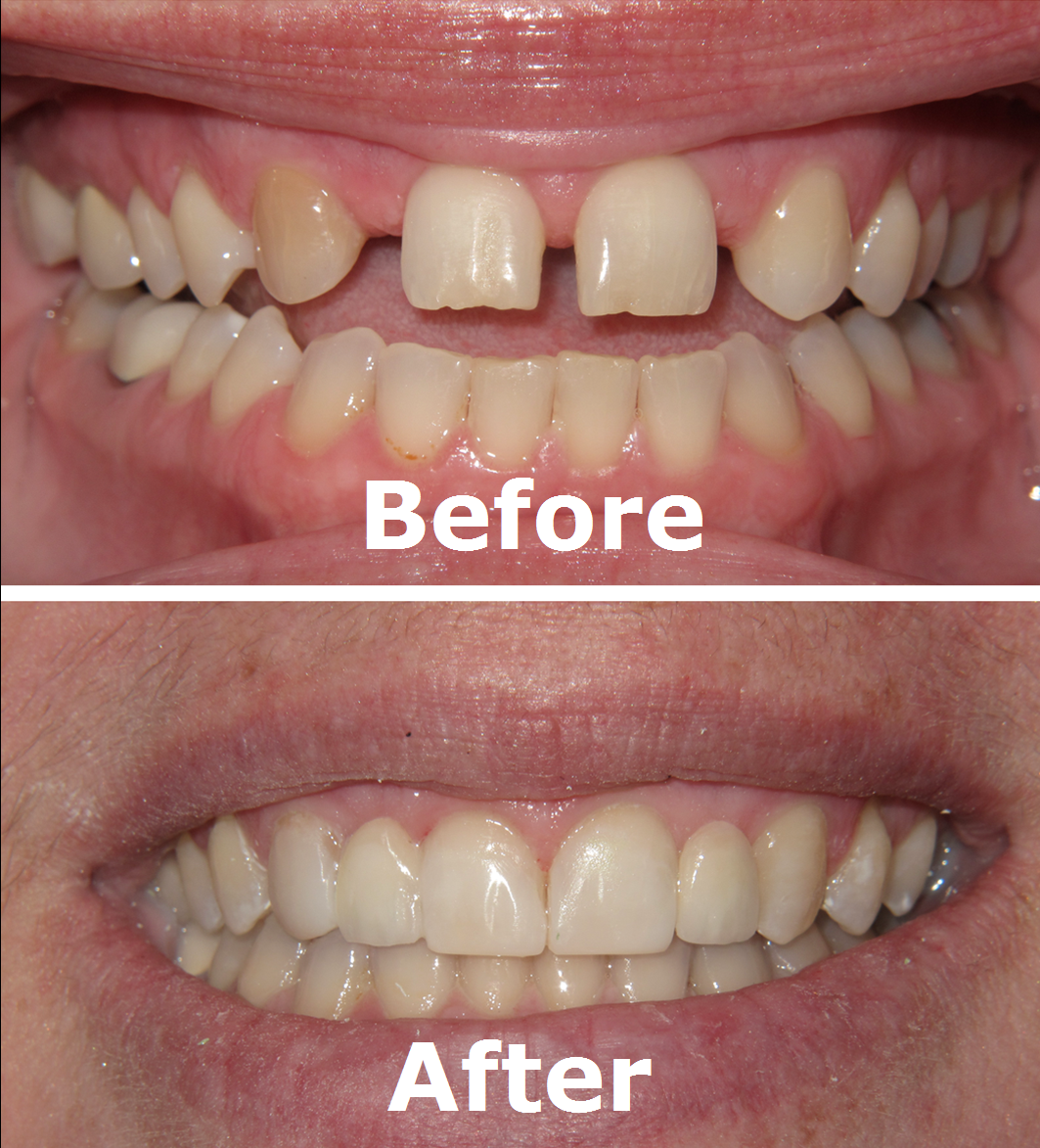
Crowns
A dental crown, sometimes called a 'cap', is a dental device that helps to maintain the structure and integrity of a tooth that has been damaged. Crowns work to maintain bone health and nerve function of the tooth by replacing the external protective structure of the tooth. Crowns are most often used to:
- Restore broken teeth
- Support a tooth that is weakened by a large filling, or several smaller ones
- Rebuild a tooth after a root canal
- Correct a bite
- Improve the appearance of a discolored tooth
- Cover a dental implant
- Provide support for bridgework
During the procedure we will first repair any damage to the tooth that is requiring a crown. Following those repairs, an impression of the shape of the tooth requiring a crown is made as well as any surrounding teeth. A temporary crown is placed over the tooth and the collected impressions are then sent to our lab and a permanent crown is fabricated. During a follow up visit, the newly fabricated crown is fitted to the tooth from which the impressions were taken and is permanently bonded into place.
Crowns can be fabricated from two different types of materials
- Porcelain Crowns - For teeth that are visible in the smile line, an all-porcelain crown is a good choice. These crowns match the color and translucent shine of real teeth and are often difficult to distinguish from the real things. These crowns may also work well if you have an allergic reaction to metals. Porcelain crowns are made of hard substances and can wear down their opposing teeth.
- Metal Crowns - For teeth that are not visible a gold crown may be a good choice. Gold crowns are very strong, can last for years, and even endure teeth grinding. If cared for properly, gold crowns can last or decades.
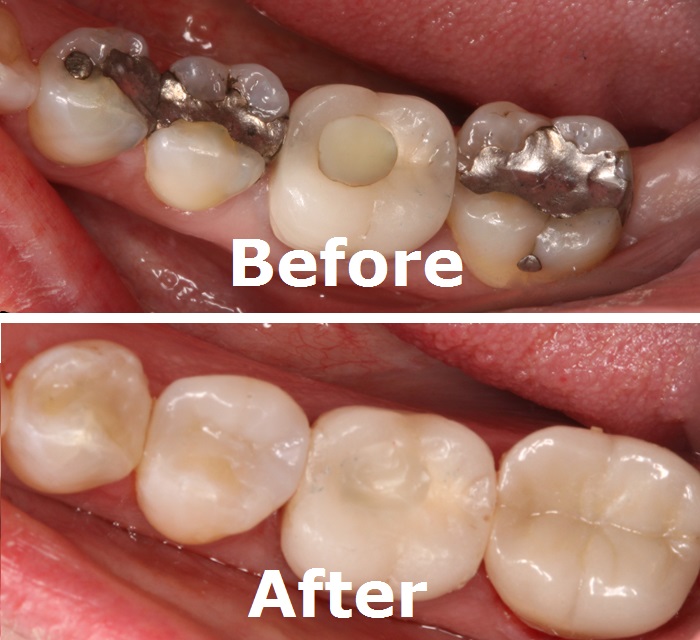
Dentures
Dentures are used to replace missing teeth, from just one or two of them to all. Partial dentures or 'partials' are used to replace one or more teeth. Full dentures, more commonly referred to as 'dentures', replace all teeth on the upper or lower arch. Both partials and dentures are designed to have the appearance of your natural teeth and gums.
Dentures might be recommended in the following situations:
- Improve the ability to chew, eat, and speak
- Restore lost facial volume
- Replace missing teeth
- Enhance your smile
Wearing dentures is a fairly simple process. Partial dentures attach to neighboring teeth with clasps that are attached to the back of each anchoring tooth while dentures are typically secured with natural suction or an adhesive. Either device can be anchored to dental implants for maximum strength and stability. As with any removable prosthesis, a proper care and cleaning routine should be established to maintain the device and a healthy mouth.
We can create and make available a custom partial or a denture in just a few visits to our office. Both prosthetics are fully customized for a completely individualized restoration.

Extractions
For some patients, extracting a tooth is the best option to reduce tooth crowding, preparing for a dental device, or to remove a tooth that is dead or dying and beyond the ability to restore it.
Extraction is a fairly common procedure. We will talk to you about the best sedation option to keep you comfortable during the procedure. Once sedated, all parts of the tooth or teeth are removed and sometimes a bone filling material, or bone graft, are placed in the extraction site to enable proper structural healing for the best long term result. Post operative instructions are given and should be followed closely to ensure that healing will occur promptly and thoroughly.
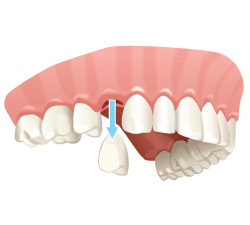
Fillings
Unlike skin, our teeth don't have the ability to self-repair. As such, a small cavity when left untreated can over time destroy the enamel and dentin and potentially infect the tooth's nerve, resulting in a painful experience. A dental restoration can stop cavities from enlarging and restore your tooth to a healthy state. A composite filling is typically used for smaller areas of decay and damaged enamel. The composite material can be color matched to the shade of your teeth, typically resulting in a restoration that is not visibly detectable. A composite resin filing is not as durable as a porcelain product and can wear or become discolored over time. Procedures that use composite resin fillings can be completed in a single appointment.
During the procedure, the tooth is prepared by removing any decay and addressing chipped or broken areas. Some fillings don't require anesthesia, but if yours do we will work to make you as comfortable as you need during the process. After the tooth is prepared, a small amount of color matched resin is injected into the cleaned cavity. The resin then hardens in place and is shaped and polished to a virtually unnoticeable finish.

Fluoride
Fluoride is a mineral found in nature that has the property of attracting other minerals. This attraction of other minerals strengthens our natural tooth enamel, and strong enamel is essential in fending off the bacteria which cause tooth decay. Children, teens, and adults of all ages can benefit from fluoride rinses, fortified toothpastes, and applied coatings.
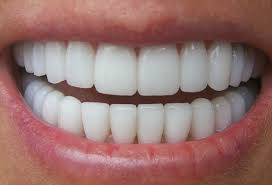
Implants
If you've lost a tooth due to injury or disease, dental implants can improve your overall oral health and bring back that bright smile.
An implant is an artificial, titanium tooth root that is surgically placed into the jawbone. A replacement tooth crown is then fixed to the titanium root, and can be made permanent or removable.
The ideal candidate for implants is a non-smoker with good oral health, including sufficient bone in the jaw to support the implant, and no sign of gum disease.

Mouthguards
Participate in a sport? A mouth guard should be part of your sports gear! A suit, helmet, pads, footwear, and gloves are all essential to peek performance and protection. Equally important is protection for the mouth and teeth. A custom mouth guard can help to protect the teeth, mouth, and jaw from injury and protect your life-time investment.

Night Guards
Grinding your teeth? A night guard will help to protect your teeth and restorative work while you sleep, reducing wear on the teeth from grinding and biting forces. A night or bite guard distributes pressure across the teeth and helps to prevent periodontal disease and a receding gum-line. Night guards are customized specifically to match your bite.
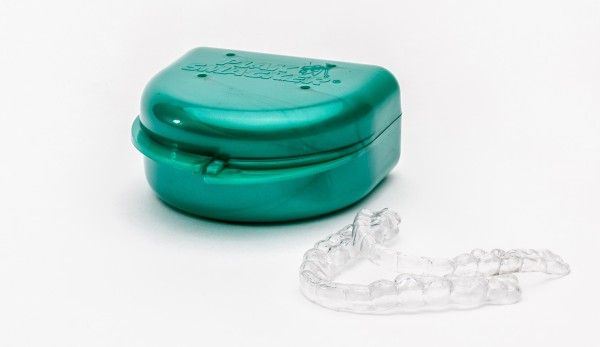
Root Canals
Sometimes a deep cavity or crack can compromise the pulp of the tooth and cause infection or inflammation. When bacteria exploit a cavity or crack and reach the nerve of a tooth it can be an extremely painful experience. Fortunately an internally infected tooth may be treatable to avoid tooth extraction. We can evaluate a tooth with this type of infection and recommend treatment of the nerve canal or possible extraction.
During a root canal, the bacterial infection and inflammation are treated within the canals of the tooth that host the nerve roots. Medicines are injected into the emptied canal and then the tooth is restored to preserve its overall strength and integrity. A root canal procedure can most often be completed in a single visit and we take extra care in making sure you feel comfortable during your visit.

Sealants
Dental sealants and preventative resins are coatings that are applied to the molars in the back of the mouth. They act as a barrier against the food particles that are the primary causes of tooth decay, sugars and starches. For youngsters, sealing hard-to-clean back teeth can reduce the risk of cavities early on and help to maintain a healthy mouth. These substances do wear off over time, so they may need reapplication after a number of years.
Sealants are typically applied to children’s teeth as a preventive measure against tooth decay after the permanent teeth have erupted. However, adults can also receive sealants on healthy teeth. It is more common to seal “permanent” teeth rather than “baby” teeth, but every patient has unique needs, and your dentist will recommend sealants on a case-by-case basis.
Sealants last from three to five years, but it is fairly common to see adults with sealants still intact from their childhood. A dental sealant only provides protection when it is fully intact, so if your sealants come off, let your dentist know, and schedule an appointment for your teeth to be re-sealed.

Veneers
Porcelain veneers are dental devices that are customized to your particular smile. These are thing shells of porcelain that are bonded in place on the front teeth for amazing results. The materials are stain resistant and are colored such that they can be matched to the color and shade of your existing teeth.
Veneers are a good option when attempting to repair items such as:
- Chips
- Cracks
- Gaps
- Misalignment
- Shape
- Stains
During an initial consultation we will discuss your desired results and then create a design and plan for your porcelain veneers. Preparations for the permanent veneers are made, impressions are taken, and temporary veneers put into place. Our lab will then fabricate your one-of-a-kind veneers for permanent installation. Once ready, you'll return for a procedure where the temporary veneers are removed and the permanent veneers are permanently bonded into place. The results of this procedure often quite remarkable and can be life changing.
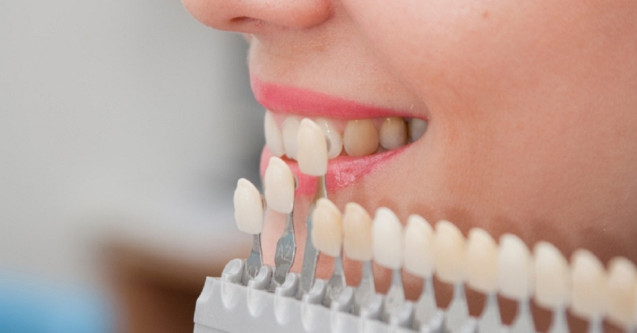
Wisdom Teeth
Wisdom teeth molars found in the very back of your mouth that usually appear in the late teens or early twenties. Wisdom teeth may become impacted, due to overcrowding or inability to erupt through the gum. When a wisdom tooth becomes impacted, it may need to be removed. If untreated, wisdom teeth may cause tenderness, swelling, or pain. Due to their location far in the rear of the mouth, wisdom teeth can be difficult to clean and as such are particularly susceptible to cavities.
Taking advantage of the lack of tooth root development and softer bone density, wisdom teeth are typically removed in the late teens or early twenties. These two factors make the extraction process easier. Recovery is involves a solid routine of hygiene in order to speed the process. Depending on the degree of difficulty related to the extractions, your healing time will vary. We will discuss the process with you and provide instructions for a comfortable, efficient healing process.
